
Stuart Moulthrop at NarraScope 1 in Cambridge (2019)
Short Version
Stuart Moulthrop is a U.S. academic active in electronic literature, game studies, and digital humanities since the late 1980s. He has published many works of computational writing, from Victory Garden in 1991 to Meccano No. 2 in 2022. His work has appeared in The Vassar Review, The Iowa Review Web, and New River. He was co-editor of the pioneering online journal Postmodern Culture from 1995-97 and edited its first issue of born-digital projects. He is co-author of two scholarly books, Traversals: The Uses of Preservation for Early Electronic Writing, with Dene Grigar (2017, MIT Press), and Twining: Critical and Creative Perspectives on Hypertext Narratives, with Anastasia Salter (2021, Amherst College Press). With Grigar, he received a Digital Humanities Startup grant from the National Endowment for the Humanities in 2013, the basis for the ongoing Pathfinders preservation effort. Two of his electronic works won the Ciutat de Vinarós prizes for narrative and (ex aequo) poetry in 2008. He was a founding board member of the Electronic Literature Organization in 1999. Moulthrop is Distinguished Professor of English at the University of Wisconsin-Milwaukee, where with the anthropologist Thomas Malaby he co-directs the Digital Cultures Collaboratory in the Center for 21st Century Studies.
Meta
The longer version that follows is really long. For all but the most interested parties, tl:dr. Memories are fractal -- always bigger inside than out. Also, they display repeated patterns, specifically these:
Longer Version
Stuart Moulthrop was born in Baltimore, Maryland, descended from Connecticut Yankees, Welsh coal miners, and a grandfather who ran in the same gang as H.L. Mencken's brother. Except for occasional work as a crab steamer and clerk typist, he has been a lifelong academic, teaching at Yale, the University of Texas, the Georgia Institute of Technology, and the University of Baltimore, before joining the University of Wisconsin-Milwaukee in 2010.
Moulthrop began programming multi-path stories in BASIC after acquiring his first computer, a Commodore VIC-20, in 1982. A few years later he learned about hypertext from Jay David Bolter and Michael Joyce, who were developing the Storyspace writing system and were mutual acquaintances of Nancy Kaplan, a teacher and software designer at Cornell. The Apple Macintosh and the HyperCard application also came into his life around this time. He began designing a HyperCard fiction called Chaos and made the acquaintance of another HyperCard artist named John McDaid who was teaching at New York University and working on his hypernovel, Uncle Buddy's Phantom Funhouse (Eastgate, 1995). When Kaplan invited Joyce, Moulthrop, and McDaid to present their work to her class at Cornell in 1988, the TINAC circle was born. The acronym may be read as "Textuality, Intertextuality, Narrative, and Computing" (McDaid), or "This Is Not a Conference" (Moulthrop), or more likely "This Is Never a Coincidence." The first product of TINAC was the Dryden Statement, named for the town through which Kaplan, Joyce, McDaid, and Moulthrop were driving when inspiration struck. Joyce wrote:
The Dryden Statement: principles regarding Interactive Multiple Fictions
I. No interruptions.
Reading should be a seamless and uninterrupted experience. Its choices proceed from the expression of possibilities as a narrative medium and depend upon the complicity of the reader in the creation of a narrative. Reading is design enacted.
II. Any person.
Interaction manifests itself through recognition, sympathy, and witness as much as through impersonation, perception, and exploration. Apprehension of character is participatory design.
III. Every ending.
Closure has been described as the completion of self by the reader. It is, in this sense, design determined.
IV. A read-write revolution.
Interactive narratives are what is written, whether by reader or writer. Authorship is an invitation to active design.
Lemme know what you think (or do or say....) Michael Joyce [1988]
TINAC would eventually include Jay Bolter, Jane Yellowlees Douglas, but never official non-member Carolyn Guyer, who was rightly skeptical of legends in their own minds.
A few years before, Moulthrop had written about Joyce's Storyspace fiction afternoon, a story (Eastgate, 1990) as a coda to his Yale dissertation. J. Hillis Miller, who agreed to direct the project in its final stages, singled out these last 18 pages as the dissertation's most (or one might suspect only) interesting contribution, suggesting they might hold promise for the future. In other words, authorship is an invitation to active design.
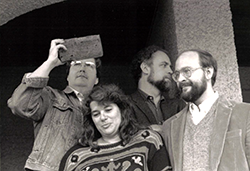
TINAC (McDaid, Kaplan, Joyce, Moulthrop) in Pittsburgh, 1989.
It took a few years for Moulthrop to figure this out, during which time he started an assistant professorship at UT Austin, wrote papers and book chapters about hypertext, and found himself in the spring of 1991 trying unsuccessfully to start a study of postmodern fiction. Active design beckoned, and when his partner Nancy Kaplan said, "you have to do what's in your heart," he turned to Storyspace and wrote the long-form fiction Victory Garden over the summer break. That project was among the first offerings of Eastgate Systems, Mark Bernstein's digital publishing house. Though it is only the third-most cited work of early hypertext fiction, behind afternoon and Shelley Jackson's Patchwork Girl, Victory Garden received a wonderful review from Robert Coover in the New York Times Book Review the following year. Coover called the work a "benchmark" for electronic writing.
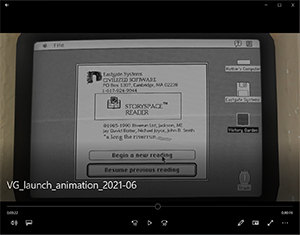 Screenshot from 3D animation of Victory Garden application running on a Mac Classic, produced by Dene Grigar's Electronic Literature Lab in 2021. Click on image to load video.
Screenshot from 3D animation of Victory Garden application running on a Mac Classic, produced by Dene Grigar's Electronic Literature Lab in 2021. Click on image to load video.
Moulthrop moved to Georgia Tech in 1992, joining a department that included Jay Bolter, Anne Balsamo, and Richard Grusin. In 1994 he and Kaplan both took jobs at the University of Baltimore, teaching in its multimedia-inspired Publications Design program. These were the early days of the World Wide Web, full of experimentation and ferment. At one point the Netscape Corporation, famous for their expansions of Hypertext Markup Language, invited Moulthrop and Catherine C. Marshall of Xerox PARC to write fictions using an unreleased technology called frames (the precursor of today's iFrames). The project foundered when some of the writing was found "too salty," and Moulthrop and Marshall pointed out that Netscape's initial documentation did not explain how to target links.
Moulthrop later made use of another HTML enhancement, a "refresh" exploit using the <META> tag to cause a webpage to replace itself automatically with another page after a span of time, for his first Web publication, Hegirascope (1995). R.E.M. guitarist Peter Buck once described the song "Stand" as "a big, dumb riff." Hegirascope is much the same, with the <META> trick acting as the riff. In its first version it allowed the reader 18 seconds to read a page and choose among four possible links. A later, expanded version (1997) stretched the reading interval to 30 seconds. At its debut Joyce called this work "the hypertext that reads itself." Reading should be a seamless and uninterrupted experience. Stand in the place where you are.
In 1995 John Unsworth and Eyal Amiran asked Moulthrop to become a co-editor of the online journal Postmodern Culture. Unsworth and Amiran had founded the journal six years earlier, laying crucial groundwork for humanities publishing on the web. Moulthrop gave up the editor's job three years into his four-year term, but managed to assemble a special issue featuring born-digital literature, with pieces from Joyce, John Cayley, Jim Rosenberg, and Diana Reed Slattery.
Around this time Espen J. Aarseth invited Moulthrop to visit the University of Bergen in Norway. Moulthrop had read Aarseth's Cybertext: Perspectives on Ergodic Literature when it was under consideration by Johns Hopkins. Through Aarseth, Moulthrop met the Finnish postmodernist Raine Koskimaa, who arranged visits to his university in Jyvaskyla, where Moulthrop came to know Cayley and the critic-experimentalist Markku Eskelinen. In later visits to the Nordic countries Moulthrop would also make the acquaintance of Jill Walker, Jesper Juul, and Gonzalo Frasca. This was the time of the so-called ludology/narratology dispute. As Aarseth and Frasca rightly point out, no such thing really happened, in large part because the writers involved, sometimes Moulthrop but more often Cayley, saw no real division. Moulthrop did memorably differ with Aarseth on one point -- whether it would be possible to create an academic field of game studies.
Happily for all concerned, game studies is now also a thing.
In 1998, Adrian Miles of the Royal Melbourne Institute of Technology offered Moulthrop a summer (winter) fellowship in Australia, where he learned about Miles' cinematic approach to hypermedia theory, was introduced to Footy by Deb Verhoeven, met the hypertext historian Belinda Barnet, and went dumb at his first glimpse of the southern stars.
Meanwhile interesting things were brewing up at Brown University. Moulthrop had longstanding ties to the digital humanists there, having made friends in his Yale days with Elli Mylonas of the Scholarly Technology Group, who organized occasional talks and dinners which often included Coover and George P. Landow. With the computer scientist Andries Van Dam, Coover and Landow had been key players in an early hypertext system called Intermedia. On the literary side, Coover had for years run an iconoclastic reading series called "Unspeakable Practices." These threads entwined with the sudden obsolescence of Intermedia and a resulting turn to Storyspace, leading to projects including Mary-Kim Arnold's Lust (1994), Patchwork Girl (1995), and Judd Morrissey and Lori Talley's My Name is Captain, Captain (2002), all created by Brown students and published by Eastgate. Intermedia aside, Brown remained interested in hypertext, and eventually other digital environments for writing, including the Computer Assisted Virtual Environment, or CAVE, which would come along a few years later.

Moulthrop, Mark C. Marino, and Scott Rettberg at ELO 2017 in Porto.
In 1999, Coover invited some people interested in digital matters for a meeting on the future of writing software, platforms, and communities. Among the outcomes of this conversation was the Electronic Literature Organization (ELO), formed to raise awareness and advocate for writing in non-print contexts. The founder and first president of ELO was Scott Rettberg, now of the University of Bergen. Moulthrop joined the ELO board of directors in 1999, resigned in a factional dispute a few years later, and was re-admitted in 2007. ELO has been Moulthrop's scholarly and creative home ever since. He hosted the 2014 annual conference in Milwaukee and shared a 2015 Bergen keynote with Aarseth.
In 2000 Kaplan and Moulthrop created a new department at University of Baltimore called the School of Information Arts and Technologies, with a graduate program in information design/usability and an undergraduate curriculum in game design. Among the hires for the new unit was Noah Wardrip-Fruin, already an important researcher on interactive media, co-editor with Nick Montfort of The New Media Reader (2003), and later author of Expressive Processing (2009) and How Pac-Man Eats (2020). After a semester, Wardrip-Fruin moved on to pursue his PhD at Brown, tapping Montfort to replace him in Baltimore. Moulthrop and Kaplan spent hours in Noah's apartment watching primitive precursors of YouTube on Nick's laptop. It was their first intimation that modern people could live without a TV set.
The Baltimore graduate program attracted a number of design professionals from the Washington, D.C. area, including Anastasia Salter, who worked with Moulthrop on a doctoral thesis about graphical adventure games, the basis of her first book, What Is Your Quest? (2014). Also taking classes at that time was Chris Klimas, an instructional designer for the University of Maryland who had an idea for a creative writing platform called Twine. Though he proposed to develop Twine as an M.S. project, Klimas' employment prevented him from studying full time. When he asked Kaplan whether he should continue toward the degree or stop out to finish Twine, she told him what she had told Moulthrop in 1991. Do what's in your heart. Klimas left, and the next Year Twine was born. (We'll come back to Twine. Like everything, it is is deeply intertwingled.)
In the last years of the century, Moulthrop's creative work began to move beyond simple HTML. Reagan Library (1999) was a hybrid webwork that used browseable panoramic graphics as the navigation scheme for a virtual world. Its concept was heavily influenced by Cyan's Riven (1997) and Moulthrop's early experiments with 3D modeling software. The prose parts included Moulthrop's first use of aleatory, replaceable text, reflecting his growing interest in scripting.
Over the next decade, Moulthrop would work primarily with Adobe's Flash software, in part because it was useful for teaching programming concepts to visual designers. Using Flash for projects like Pax (2003), Moulthrop became proficient with ActionScript and JavaScript, and with the rudiments of object-oriented software design. He also experimented with another tool used in teaching, Graham Nelson's Inform language, first in its more conventional Version 6 and then in the natural-language idiom of Inform 7 -- though he has yet to produce anything publishable in this way. Repeating his previous pattern, Moulthrop spent a sabbatical in 2007 failing to write another scholarly book, instead turning out a trio of Flash works, Radio Salience, Under Language, and Deep Surface. Though these projects use graphics and animated effects, their scripts are considerably more extensive than is typical for Flash. This makes them hard to convert to current platforms, though emulation may ulimately be possible.
In 2009 the University of Wisconsin-Milwaukee (UWM) advertised an open-rank position for a "theorist and practioner" in digital media with an interest in computer games. Moulthrop applied and was eventually offered the job. Moving to a supportive, research-intensive university meant more uninterrupted time for creative work, allowing more gradual development of ideas. Ironically, this meant fewer new publications for a few years, as longer-term projects got underway and some experiments fizzled, though ultimately that pattern would reverse.
In the summer before the move to Milwaukee, Moulthrop was invited along with Aarseth to take part in a symposium at the Porter Institute for Semiotics at Tel Aviv University. The experience left both wishing for something similar in game studies, leading Aarseth to propose a single-track conference on Games and Literary Theory. Moulthrop attended the planning event in Malta in 2012. He and doctoral student Justin Schumaker contributed a paper to the first serial conference, again in Malta, in 2013, and Moulthrop attended the third conference in New Orleans in 2015.
UWM had developed a program in Modern Studies, part of the same intellectual project that produced the Center for 20th (later 21st) Century Studies. With the decline of the literary theory boom at the end of the century, Modern Studies transformed into a comparative media studies program with roots in film studies -- Media, Cinema, and Digital Studies. Moulthrop became part of that enterprise, offering new graduate and undergraduate classes in game studies and digital culture, including courses on film and game. He served as coordinator of the program from 2017-20.
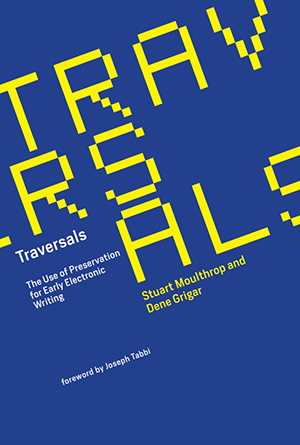
In 2012 Wardrip-Fruin, now at UC Santa Cruz, invited Moulthrop to attend a summit meeting of academics, industrial researchers, and government grant officers. During this event Moulthrop re-encountered his Georgia Tech colleague Balsamo, sharing with her his concerns about platform obsolescence and digital works from the turn of the century. Balsamo had heard similar things from Dene Grigar on a recent visit to her lab at University of Washington Vancouver. Over the next month, Grigar and Moulthrop wrote a proposal to the National Endowment for the Humanities, funded in 2013. This was the start of the Pathfinders project, in which authors and volunteer readers are video-recorded playing through early digital literary works, using the original hardware platform or near equivalents. These performances are called traversals. The first phase of Pathfinders worked with four texts, Judy Malloy's Uncle Roger (1987), McDaid's Uncle Buddy's Phantom Funhouse (1995), Jackson's Patchwork Girl (1995), and Bill Bly's We Descend (2003). Moulthrop produced a traversal of Victory Garden as rehearsal for the main recordings. Grigar has continued to expand the archive of traversals and has transformed the effort into an extensive preservation project that will eventually involve other 1990s multimedia, such as Voyager's Expanded Books, moving on to Flash works. Moulthrop and Grigar wrote a series of critical-textual studies based on Pathfinders which became Traversals: The Uses of Preservation for Early Electronic Writing. The book was published by MIT Press in 2017.
In another case of This Is Never a Coincidence, Moulthrop's old Tech colleague Grusin came to the UWM English department, and directorship of the Center for 21st Century Studies, at the same time Moulthrop moved to Milwaukee. When Grusin invited faculty to organize research "collaboratories," Moulthrop joined with the anthropologist Thomas Malaby to create the Digital Cultures Collaboratory. The Collab sponsors Serious Play, an ongoing effort by faculty, staff, and graduate students to research games and their communities through reflective practice. Begun by Moulthrop, research librarian Nathan Humpal, and doctoral students Justin Schumaker, Kris Purzycki, and Laya Liebeseller, Serious Play began with occasional sessions of play and discussion, grew into a weekly series of mid-day meetings ("Lunch Zone"), and eventually, through the efforts of anthropologists Krista Lee Malone and Josh Rivers, became a channel on Twitch.tv. The Serious Play channel now involves about a dozen graduate students in Anthropology and English and produces 6-8 weekly shows. Serious Play became a Twitch affiliate in 2018. In 2020-21 members of the group edited a special issue of the Popular Culture Society Journal focused on live-streaming. In spring of 2021 the Collab conducted an online Live-Streaming Symposium in conjunction with the Center for the Study of Games in the University of Jyvasykyla.
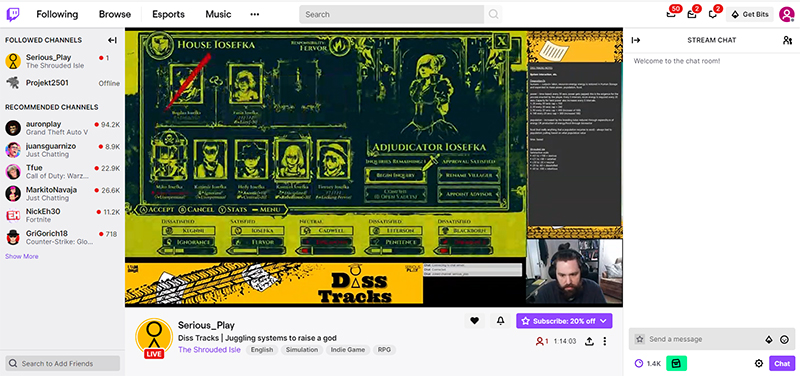
Ryan House's "DissTracks" show on the Serious Play channel, 2021.
Meanwhile, Moulthrop has continued to produce creative work. Advent of the iPad in 2010 piqued his interest in app development, amplified by his admiration for Erik Loyer's Strange Rain (2011) and Danny Cannizaro and Samantha Gorman's Pry (2015). In 2014 Moulthrop completed an app fiction called If You Please, which he presented in the ELO reading at the 2014 conference of the Society for Literature, Science, and the Arts. Though the project featured significant advances in Moulthrop's use of substitution grammars, it was not especially pleasing and was set aside. The experiment taught Moulthrop that app development tools are as complex and difficult as their counterparts in game development. This made a return to HTML and the web attractive. In 2011 Moulthrop had published an "arcade essay" called SC4NDA1 in New Media based on a passing remark in Ian Bogost's Persuasive Games -- basically, never do this. The work was produced first in HTML5, then ported to Flash after users reported transient problems with the HTML animation. The project introduced a design pattern Moulthrop has re-used throughout the decade: a primary linear text punctuated by contingent and/or randomized events. Moulthrop has begun to think of these works as "interruptive fictions."
His next work of fictive interruption was a remix of Michael Joyce's novel Was: annales nomadiques (2007), subtitled "a novel of internet." The project, initially called "R" until Moulthrop became aware of the popular research tool by that name, uses a textbase of extracts from Joyce's novel as Google search terms, generating a second textbase. The two sources are programmatically remixed with random variation to produce a fresh novella-length text whenever the host page is loaded -- novel of internet plowed under and redug, with intimations of flarfism. Moulthrop worked on this idea from 2011-13. It was his main project during his In(ter)ventions residency at the Banff Centre for the Arts in 2012. However, Moulthrop hesitated to complete the work. At first he was wary of exceeding fair use allowances in the remix, then he discovered the programming technique he was using to process XML files is no longer supported in JavaScript -- a rare occurrence on the web. The Was project continues in development under the working title "Nineteen Floor TV."
The next interruptive effort was The End of the White Subway, published in New River in 2016. It was an attempt to deconstruct the logic of games by inverting the relationship of play and story, using a dynamic in which the reader/player can end the encounter at any point and must repeatedly re-commit to the play of language in order to continue. This was followed in 2017 by Show's Over, written at Joyce's invitation for an online reboot of The Vassar Review, and in the aftermath of November, 2016. In this work the intervening, generated material is an endless series of movie credits, reviving a very weird idea Joyce, Moulthrop, and McDaid entertained in the 1990s, for a cable TV channel that would present nothing but credit rolls.
In 2016 James Brown, Jr. of the Rutgers-Camden Archive of Digital Ephemera (R-CADE) organized a symposium on Uncle Buddy's Phantom Funhouse. Participants were asked to produce original work using the materials of McDaid's 1995 novel-in-a-box. Projects included crafty fan-art and an ingenious sound loop from Steph Ceraso, a web rendering of McDaid's "Oracle" stack by Darius Kazemi, and a brilliant video presentation on the Funhouse implementing the "Buddy System" VR parody, by Robert Emmons. Moulthrop's contribution was Sharing the Fantasy, an endlessly looping transcript of a surreal SF convention session, created in HyperCard on a vintage PowerBook and ported to HTML. The session in question was mentioned in the 1995 text of the Funhouse. Among other things, this project demonstrated how little Moulthrop's programming technique had evolved in 30 years.
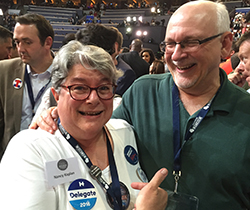
Kaplan and Moulthrop at the Democratic National Convention, 2016. Photo by John McDaid.
The R-CADE event was the first of two visits by Moulthrop to Philadelphia in 2016. In July he accompaned Kaplan who attended the 2016 Democratic National Convention as a Clinton delegate. See photo by McDaid, on scene as a journalist. We all know what happened next.
In 2017 UWM granted Moulthrop what would probably be his final sabbatical leave, and this time he didn't bother with an academic book (though one would come along) but spent the whole semester on new digital efforts. Among the outcomes was a collaboration with long-time friend and fellow artist Deena Larsen, called Ouroboros-Jabberwock. This work features alternation instead of interruption, enabling the reader/player to coordinate attention across two ongoing streams: a spoken poem by Deena accompanied by hyperlinks, or Stuart's re-imagining of Jabberwocky as a never-ending tennis match. Moulthrop presented the work at the ELO Conference in Porto in 2017.
Two other fairly small projects begun during the sabbatical appeared over the next two years. Stromatolite (2020) is an oneiric prose poem buried in bacterial mats of language, inspired by a strange dicovery during work on the Was project. Moulthrop submitted this composition in response to the journal Taper's call for poetry generators of no more than 2,000 kilobytes. It did not fit the constraint, so Moulthrop instead created Why2k (2018), which slipped through the needle's eye.
In early 2017, in the same post-2016 turn of mind that produced Show's Over and his essay, "'Just Not the Future,'" Moulthrop started working on a narrative interruptus for the global disaster, focusing on the evil of Orange Twitter. Emaji naratgee marakka is a hopeful fable begging to be rescued from a stack of trollish spew. It is awaiting publication on Lyle Skains' Wonderbox platform.
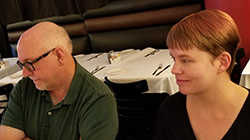
Moulthrop and Anastasia Salter at ELO 2014, Milwaukee.
By the usual vicus of recirculation, Moulthrop found his way in late 2017 into a conversation with Salter, who had also become interested in the Twine platform. This was partly because of the (tenuous) old school tie to Klimas and the work of people like Leon Arnott and Dan Cox, but mainly because of the impressive achievements of indie artists Zoe Quinn, Dietrich "Squinky" Squinkifer, Porpentine Charity Heartscape, Anna Anthropy, and many others. Salter was planning a book about Twine and its cultural moment. Moulthrop asked to join as second author. It is very hard to say no to your old thesis advisor. Twining: Critical and Creative Perspectives on the Twine Platform was published by Amherst College Press in 2021.
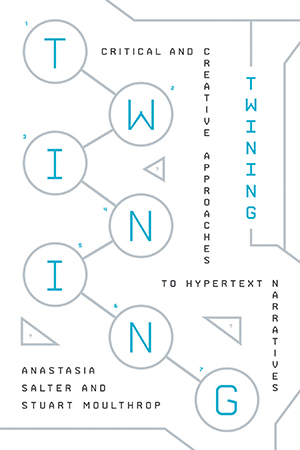
Cover of Twining.
Also appearing in the harvest months of 2020 was "1000 Words into the Future of Text," Moulthrop's (rather louche) contribution to an all-star volume of essays on text and its future, recruited by Frode Hegland of Liquid.
Moulthrop has several plans for years ahead, depending on circumstances: